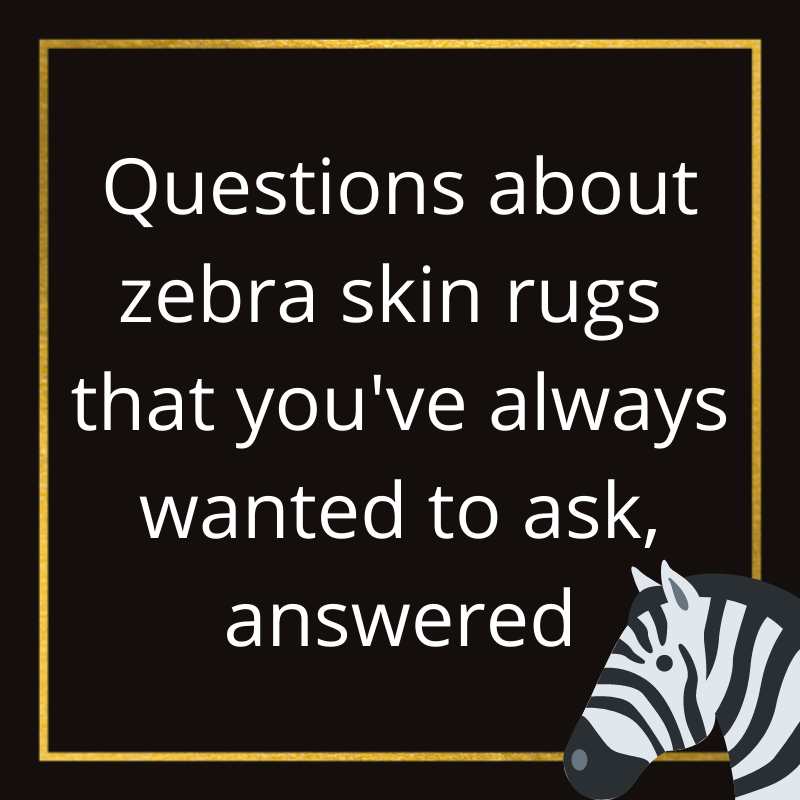
Answers to Zebra Rug Questions You’ve Always Wanted to Know
Share

Investing on high-quality items such as a zebra hide rug (an authentic one, that is) requires a good amount of research. That's how it should be.
It is your right to dig deep and have the best information on your hands before you make that long-term commitment.
So, we've collated questions about zebra skin rugs and answered them to help you make an informed decision. Read on to find out!
Why are real Zebra rugs expensive?
Different factors make them expensive, one of which is sourcing. Zebra skin rugs are imported from Africa—specifically, Eastern and Southern Africa. The temperature and the fact that they can grow at a natural rate in these areas without artificial help make their hides stronger.
Another reason is the quality of the zebra rug. Zebra rug comes in different grades. Trophy Grade is the Bugatti of zebra hides. They’re free of imperfections.
Grade A zebra skins have some, but they’re very minimal. Grade B, on the other hand, has scars that can only be seen upon close inspection. Grade C has a tad bit more scars than Grade B, but still not enough to earn a sigh of disappointment. In other words, it’s still a sight to behold.
The third reason is the laws that safeguard these species. Legal zebra skin rug sellers like us go through the required process to obtain an import certification and a license from the U.S. Fish and Wildlife Services, to name a few.
Are zebra skin rugs legal?
Not all zebra skins are. This is why you need to do your due diligence before buying one. Burchell's zebra is the only subspecies that can be legally farmed and sold. They are not endangered, unlike the Grevy’s zebra. In fact, Burchell's zebras are culled to prevent habitat degradation.
How long should a zebra rug last?
This depends on the quality of the zebra hide and how well it’s taken care of. Zebra rug needs some TLC every once in a while to prevent premature degradation. They can last for years—long enough to be passed on to the next generation—when properly cared for.
How do you clean a zebra rug?
The cleaning method depends on the degree of dirt or stain. Don’t worry. You can DIY most of it.
Let’s start with the basic: routine cleaning. Gently brush your zebra rug in the direction of hair growth to keep it looking clean and new.
Dirt and Light Stains: A good ol’ mild organic soap-and-water combo will do the trick. Lightly dip a sponge in the mixture. Make sure to wring it out well before pressing onto any visible dirt. A caveat: avoid getting your zebra rug too wet.
Tea, red wine, coffee, and other liquid stains: Start the procedure as soon as it happens. Sop up the liquid with paper towels. Once it’s thoroughly dry, scrape it off using a brush or the blunt edge of a knife. Dip a sponge in a soap-and-water combo, and then gently rub the rest of the stain with it.
Pet urine: It’s best to use a pet stain remover, preferably, an organic one.
Will a zebra rug gain value over time?
This depends on several factors, such as the quality of the rug. Some go up in value and are prized by collectors.
How much does a real zebra rug cost?
Expect to shell out more than $1,000 for exemplary zebra hides. Real zebra skin rugs that are ethically sourced and legally sold are very expensive. In our case, we wait for the culling season to procure the very best zebra hides. Because of that, we don’t have a massive inventory to meet a demand surge.
Got more questions? Feel free to contact us anytime!
